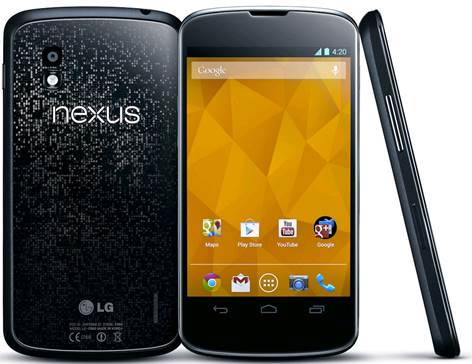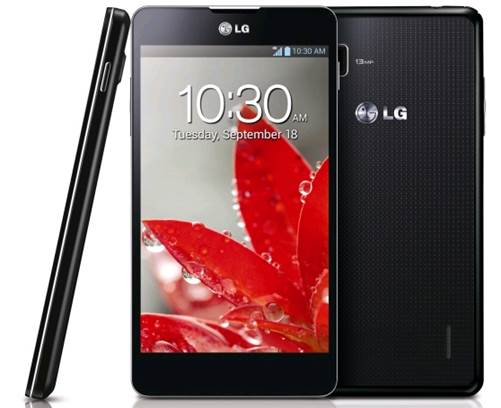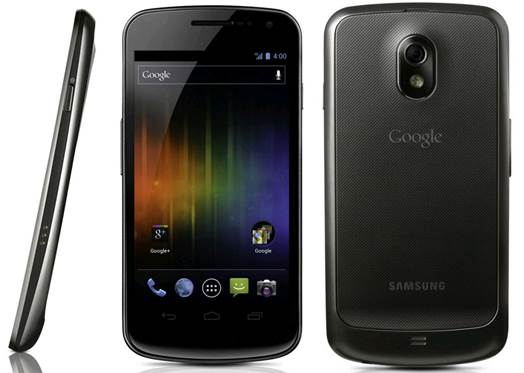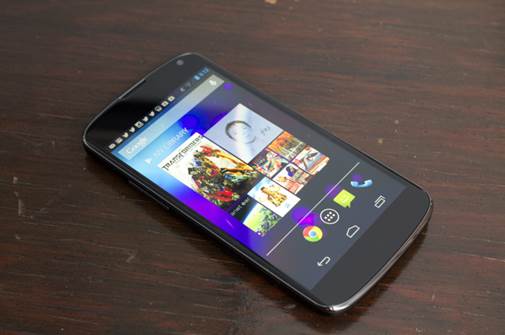Finally, Nexus 4 supports a full pack of
wireless charging standard, which means that you can sue any Qi supportive
charging pad to fill up your battery – we even try it on the Fatboy charging
pillow that is sold by Nokia, and it works like a miracle. So, what are the
differences about this stunning phone? Let’s check the following specs for all
details.
Nexus
4 specs
·
Dimension: 5.27x2.7x0.36 inch (133.9x68.7x9.1mm)
·
Weight: 4.9 ounce (139g)
·
Screen size: 4.7 inch
·
Screen resolution: 1,280x768 pixel (320ppi)
·
Screen size: True HD IPS Plus
·
Battery: 2,100mAh
·
Internal storage: 8GB or 16GB
·
External storage: No microSD slot
·
Rear camera: 8MP, AF, LED flash
·
Front camera: 1.3MP
·
Video recording: 1,080p
·
NFC: Yes
·
Radio: HSPA+, 42/UMTS: 850/900/1,700/1,900/2,100,
GSM/EDGE: 850/900/1,800/1,900
·
Bluetooth: V4.0
·
SoC: Qualcomm APQ8064 Snapdragon S4 Pro
·
CPU: Quad-core 1.5GHz
·
GPU: Adreno 320
·
RAM: 2GB
·
HDMI options: Slimport (landline)/Miracast
(wireless)
·
WiFi: 2-band 802.11b/g/n
·
OS: Android 4.2 Jelly Bean

Nexus
4
LG
Optimus G (Korean version) specs
·
Dimension: 5.19x2.71x0.33 inch
(131.9x68.9x8.5mm)
·
Weight: 5.11 ounce (145g)
·
Screen size: 4.7 inch
·
Screen resolution: 1,280x768 pixel (320ppi)
·
Screen size: True HD IPS Plus
·
Battery: 2,100mAh
·
Internal storage: 32GB
·
External storage: No microSD slot
·
Rear camera: 13MP, AF, LED flash
·
Front camera: 1.3MP
·
Video recording: 1,080p
·
NFC: Yes
·
Radio: GSM/GPRS 850/900/1,800/1,900; UMTS/HSPA+
900/2,100; 3-band LTE
·
Bluetooth: V4.0
·
SoC: Qualcomm APQ8064 Snapdragon S4 Pro
·
CPU: Quad-core 1.5GHz
·
GPU: Adreno 320
·
RAM: 2GB
·
HDMI options: MHL (landline)/Miracast
(wireless)
·
Wi-Fi: 802.11 a/b/g/n
·
OS: Android 4.0.4 ICS

LG
Optimus G
Samsung
Galaxy Nexus (HSPA version) specs
·
Dimension: 5.33x2.67x0.35 inch
(135.5x67.9x8.9mm)
·
Weight: 4.76 ounce (135g)
·
Screen size: 4.65 inch
·
Screen resolution: 1,280x720 pixel (316ppi)
·
Screen size: Super AMOLED HD (PenTile)
·
Battery: 1,750mAh
·
Internal storage: 16GB
·
External storage: No microSD slot
·
Rear camera: 5MP, AF, LED flash
·
Front camera: 1.3MP
·
Video recording: 1,080p
·
NFC: Yes
·
Radio: HSPA+ 21/UMTS: 850/900/1,700/1,900/2,100;
GSM/EDGE: 850/900/1,800/1,900
·
Bluetooth: V3.0
·
SoC: TI OMAP 4460
·
CPU: Dual-core 1.2GHz
·
GPU: PowerVR SGX540
·
RAM: 1GB
·
HDMI options: MHL
·
Wi-Fi: 2-band 802.11a/b/g/n
·
OS: Android 4.1 Jelly Bean

Samsung
Galaxy Nexus
Screen
A quick examination on the specification
sheet above let us know that basically, the screen is identical to the one used
on the new-launched LG Optimus G, the close siblings of Nexus 4. Looking back,
it’s better than the HD screen that Galaxy Nexus has. What we’re seeing (in the
literal sense) is the 4.7 inch True HD IPS PLUS screen, 1,280x768-resolution, along
with a slab of Gorilla Glass that covers it. However, with Nexus 4, the slab
equipped by Corning has a more important role than on other smartphones. LG has
developed the tech that integrates the touch sensor of the screen to the outer
glass slab. This not only creates a thinner phone, but also brings the pixels
closer to the screen. (This sounds familiar, that’s because Apple has done
something similar to iPhone 5 and Surface for Windows RT of Microsoft).

What
we’re seeing (in the literal sense) is the 4.7 inch True HD IPS PLUS screen,
1,280x768-resolution, along with a slab of Gorilla Glass that covers it
Besides, WXGA resolution express into 320ppi
pixel density, but the layout of the RGB sub-pixel means that it actually pack
more visual power than the PenTile Super AMOLED HD screen on Nexus of last
year. There’s less of broken pixel – if any and the excellent viewing angle,
giving us a better opportunity to read newspaper and watch movies than most of
other devices we have used. It’s also one of the best screens we’ve ever seen
in midday sunlight. We can see everything clearly at the brightness of about
50%, and at least it’s still easy to read with the settings lowered to 30%. This
screen is one of the best one you can have at the moment, and equal to the 720p
screens we have played on One X and Samsung Galaxy S III. It’s between these 2
rivals when talking about color saturation. The black color is as black as you
can see on One X (but behind GS3), and the white color is brighter than the 2
competitive phone. We also realized that Nexus shoes the darkest red and
magenta, as well as the lightest green and yellow. As a result, your viewing
experience may be a little different compared to other 720p screens, but we’re
very satisfied with what we have seen on Nexus 4.